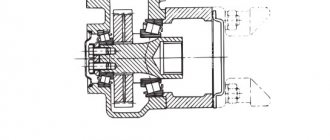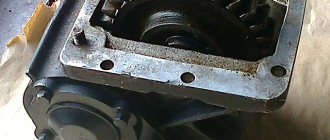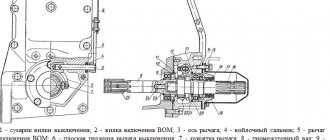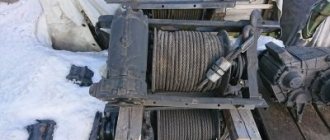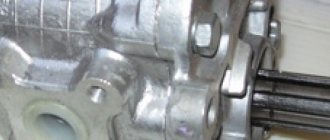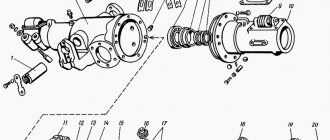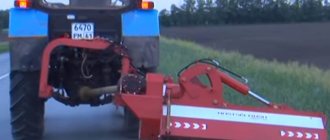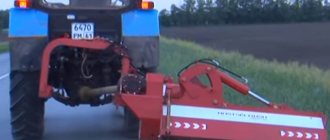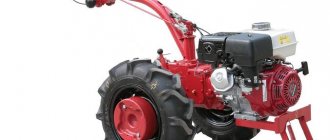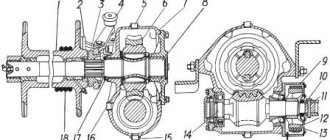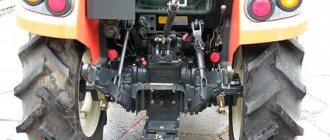The mechanism that drives components on a truck chassis using hydraulics or a driveshaft is called a power take-off (PTO). They are used on specialized vehicles: tanks, municipal vehicles, truck cranes, etc. The mechanism is activated from the driver’s cab. Sometimes a reversible PTO is installed, where the input shaft can rotate in two directions. Most often, the boxes work while the car is stationary, but there are exceptions when the work is carried out in driving mode. For example, street cleaners. That is, the box can operate in any gear, including neutral.
What are the types of malfunctions and how to recognize them
The cause of increased noise when the truck is operating may be a large gap between the gearbox gear and the PTO. The sealing gasket between the flange and the box must be at least 0.6 mm.
Self-switching off of the gear unit can indicate an unsatisfactory fit of the unit on the splines of the driven shaft.
The power take-off is not functioning and air is coming out of it. Possible rupture of the diaphragm pneumatic chamber/poor tightening of the components on the rod/damaged gear teeth/bent fork.
The mechanism does not turn on completely. Spring parts may break.
When disconnected, the control lamp lights up. The spring is broken/clutch teeth, shaft or gear are damaged.
The alarm indicator lamp does not light up. The fuse/light bulb is burned out/the diaphragm is damaged/the fasteners on the rod are loose/the solenoid valve is broken.
The power take-off does not turn off. Check the serviceability of the electro-pneumatic valve in the transmission unit of the truck.
Oil leaks at mounting points. The bolts are loose/the gaskets or copper washer are worn or damaged.
The pump is not working. The oil supply tube may be damaged/nuts may be loose/oil passages may be clogged/depressurization may occur.
Modern look
To understand what exactly to buy for your iron horse, it is best to determine what type of roads it will be driven on and in what weather. It is also worth considering what season the wheels are purchased for - summer or winter.
These wheels have several advantages. The first and most obvious of them is an attractive appearance. Indeed, the manufacturing technology is such that in this case it is possible to achieve quite complex, voluminous ornaments and patterns, as well as a more complex texture. In addition, the color range of cast varieties is very rich, which allows you to give your car a more modern appearance and really make it look better.
Particularly interesting is the technology for making cast models and the method of molding them. In fact, the method by which production is carried out logically follows from the name of this variety. Thus, the metal is heated and melted in advance, which makes it possible to obtain a uniform, liquid and thick emulsion. This emulsion is poured into a prepared mold, where the metal cools and hardens.
When the part has already acquired the required appearance, the iron is processed and polished, where minor defects and external imperfections are removed. Then priming and painting are carried out, which will prevent corrosion and signs of metal destruction from appearing.
How to repair a COM, step-by-step instructions
Step #1. Removing the OM box
Remove/drain the remaining oil from the crankcase and oil tank.
We disconnect the air supply hose into the chamber from the pipeline and turn off the alarm from the electric drive.
Remove the sleeve and high pressure pipe from the oil pump flanges.
Unscrew the mounting bolts and remove the power take-off box.
Step #2. Let's disassemble the box
Bend the lock washer and unscrew the axle bolt. We press the axle out of the crankcase, remove the drive gear and spacer element.
We unscrew the alarm switch from the crankcase and remove the adjustment washers. Unscrew the bolts of the pneumatic chamber cover and remove it. Unscrew the diaphragm nut on the rod, remove the Belleville washer/diaphragm/next nut/spring.
Unscrew the bolts securing the camera body to the PTO housing. We take out the body. We unscrew the bolts of the bearing cover, remove it and the spacer element.
Use special pliers to remove the retaining ring from the groove, press out the shaft and press the bearing off of it. Remove the bearing and driven gear from the crankcase. We unscrew the rod from the fork and remove it. Remove the sealing ring.
All spare parts are washed, cleaned and checked for suitability. If cracks or other defects are detected, we replace them with new ones. It is fashionable to weld cracks in the crankcase.
Step #3. Assembly
Before assembling, the parts and the surface of the box must be lubricated with oil. We assemble in the opposite sequence to removal. We check the air duct connection to ensure there are no leaks. We check the electro-pneumatic system using the warning light on the instrument panel. We regulate the stroke of the ball using the number of washers.
During maintenance, we check the oil level, add or replace it. We adjust the bearings of the drive/intermediate shafts, paying attention to the gaps. Adjust the position of the couplings. We periodically disassemble the power take-off and lubricate the spare parts.
For exact prices, please contact our managers by phone.
Transfer case purpose
The purpose of the transfer case (TC) is to distribute the transmitting force between the drive and additional axles. The transfer case also allows you to turn the drive axle on or off and, in some cases, reduce or increase the gear ratio and thereby double the number of existing gears used for the vehicle’s gearbox.
All-wheel drive diagram with transfer gearbox
Such driving is especially important when driving on a good highway; the transfer gearbox allows you to disable the additional axle, thereby relieving the load on the engine and reducing fuel consumption for the transmission. The creation of a transfer case dates back to the beginning of the twentieth century, when car racing on highways and off-road conditions began to develop.
The use of such a unit is especially necessary for trucks where it was planned to use an additional axle axle. It was necessary to somehow balance the torque between the two axles.
As soon as the car gets into off-road conditions, the use of a transfer case together with a center differential helps the engine distribute rotating torque to the axles in the required proportion to the weight of the load, ensuring that the wheels of different axles rotate evenly at the same speed, thereby reducing the load in the transmission and reducing the wear of mechanisms, and most importantly, the car overcomes obstacles and moves smoothly in bad road conditions.
We carry out clutch repairs on the following trucks:
Man
Three Latin letters “MAN” on the hood of the car are a symbol of the quality of the German heavy automotive industry. Russian...
Mercedes
…
Renault
…
Scania
There is a special category of trucks that have proven themselves well in harsh Russian conditions, when...
DAF
…
Types and properties of alloy wheels
All light alloy wheels can be divided into two large groups: cast and forged.
The name “cast disk” indicates that the part is made from light metal alloys using the casting method. The main material for the manufacture of cast wheels is aluminum. However, sometimes there are wheels cast on a magnesium basis.
Simplified, the manufacturing process can be represented as follows:
- A melt with a set of metals and additives is prepared in a metal smelting furnace;
- Then the molten mass is poured into special molds;
- After this, finishing machining of the cast workpiece is performed;
- At the last stage, a paint coating is applied to the surface of the disc to protect it from corrosion.
Forged wheels are produced using a different technology: a light alloy metal blank is heated and subjected to pressure treatment in a special press, that is, stamping or forging.
To produce each type of forged disc, you need your own separate stamp, which is quite expensive. Therefore, the choice of forged alloy wheel models is somewhat poorer than that of their cast counterparts.
Advantages of alloy wheels
The most obvious advantage of alloy wheels is their attractive appearance. A car equipped with “casting” looks richer and more solid. This axiom applies to both forged models and cast wheels.
Alloy wheels are much lighter than stamped steel wheels of comparable size. For example, the weight of a 13-inch wheel varies within the following limits:
- steel stamping – 8 kg,
- light alloy wheel – 6 kg,
- forged disc – 5 kg.
When using alloy wheels, the load on the suspension is reduced, the moment of inertia during deceleration is reduced, acceleration dynamics are improved, and the wheel returns to its original position faster when driving over potholes.
Disadvantages of alloy wheels
Among the main disadvantages of alloy wheels, their fragility should be noted. With a strong impact, the disc does not deform, but cracks or chips. Most of these damages cannot be repaired.
Forged wheels are the most durable, however, with a strong impact on the wheel area, all the power falls on the suspension parts, disabling them. So repairing the suspension, steering mechanism and drive shafts can ultimately cost more than replacing a wheel rim.
An unpleasant moment when driving on all types of “casting” can be an imbalance of the wheels. This happens most often for two reasons:
- Since the balancing weights are glued to the inner surface of the disc, they come off quite often.
- When driving off-road and in mud, sticky road debris gets stuck in the beams of fancy alloy wheels. Even when dry, it does not lag behind the surface of the disc, disrupting the wheel's balance.
The main recommendation for using alloy wheels is to drive carefully on rough roads, especially on low-profile tires.
You also need to exercise care and caution when parking near curbs and ribbed bollards. Alloy wheels are designed for good cars and excellent roads
Dependent boxes
Here we are talking about clutch dependence. Such devices are usually located on vehicles equipped with manual transmissions. Such systems are relevant to use in cases where attachments do not need to be turned on on the go, that is, while the vehicle is moving.
Dependent boxes have several main advantages:
- they are light in weight, which simplifies working with them during repair and maintenance;
- the repair itself does not cause any difficulties if you have a certain level of knowledge;
- if the box is in the off state, such PTOs do not additionally load the engine;
- the design is quite simple and reliable;
- they have a long service life;
- maintenance requirements are minimal;
- high level of safety, since the selection box cannot spontaneously start working while on the move.
Installing dependent boxes is extremely simple. A specially designated place is provided for this. The hatch is first dismantled. If the location is top, a pump is additionally used in the circuit.
Dismantling work is also simple. If the main gearbox is removed, this will not affect the operation in any way.
